Build a Microsoft Teams lifecycle management plan: Archiving and deleting inactive teams

Table of contents
Just like team creation, you need to have a plan for end-of-life. Create a strategy for identifying teams that have reached the end of their useful life, and decide whether to archive or delete them.
All good things must come to an end, and this is true of your teams as well. When your teams were created, it was probably with a specific goal in mind—to bring a project to life, a specific group of people together, or to facilitate conversation around a certain topic. Once this goal has been achieved, or priorities within the organization have shifted elsewhere, the team will fall out of use.
When that happens, you'll want to have a plan in place so you know how to deal with the team and its content. Keeping outdated content kicking around your tenant can lead to confusion among your users, but on the other hand some important data may be worth keeping.
In the third and final instalment of our series on building a lifecycle management plan, you'll learn what policies you can put in place and actions you can take to maintain an organized and secure Microsoft Teams environment as your teams reach the end of their useful life.
Don't forget to check out part 1 of this series, on team creation, and part 2, on managing active teams if you haven't already!
Applying expiration policies in Microsoft Teams
Once your teams have served their purpose, what happens to them? All too often, they end up overstaying their welcome in your tenant, creating clutter and causing confusion among users.
As an admin, you can create a Microsoft 365 group expiration policy which will automatically clean up your unused teams. Teams are backed by groups, so this policy will automatically apply to your teams as well.
When an expiration policy is applied to one of your teams, that team's owner will be notified on three separate occasions: 30, 15, and 1 day before the team's expiration date. If the team owner doesn't take any action, then that team will be soft-deleted. Teams that have been soft-deleted can still be restored within the next 30 days.
When a team expires, so does its associated services, like its mailbox, planner, and SharePoint site.
Auto-renewal of active teams
But what if the team owner is away, or doesn't manage to renew the team before it's set to expire?
Microsoft has a built-in failsafe feature for teams that have a group expiration policy applied to them. This feature allows teams that are actively in use but that haven't been renewed by the team owner to renew automatically, preserving your important data and preventing the wrong teams from being deleted.
Find inactive Microsoft Teams teams
Keeping your environment tidy and efficient means regularly cleaning up teams that no longer serve a purpose—but first, you'll have to find them. There are a few ways to find the inactive teams in your environment.
First, let's look at how you can use Microsoft's tools to unearth obsolete teams and take the first step towards cleaning them up.
Microsoft Teams usage report
The Teams usage report in the Microsoft Teams admin center allows you to track user adoption and see who is using Teams and how they're using it.
How to view the Teams usage report
- Navigate to the Microsoft Teams admin center. On the left-hand side, click Analytics & reports, then select Usage reports.
- On the View reports tab, in the Reports drop-down menu, select Teams usage.
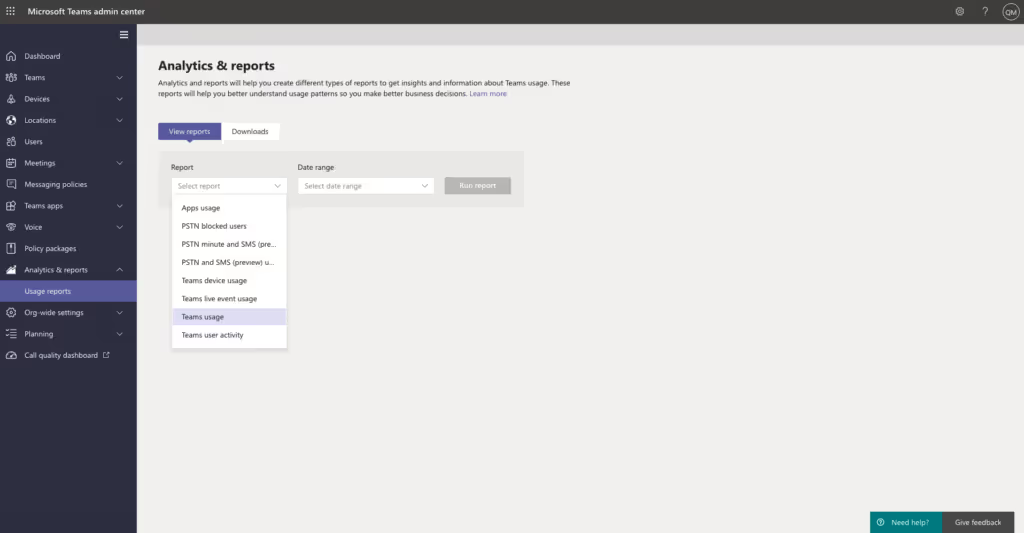
3. In the Date range drop-down menu, select either Last 7 days, Last 30 days, or Last 90 days. Then click on Run report.
What the Teams usage report can tell you
The report will show you activity trends within your teams according to the time period you specified when generating it.
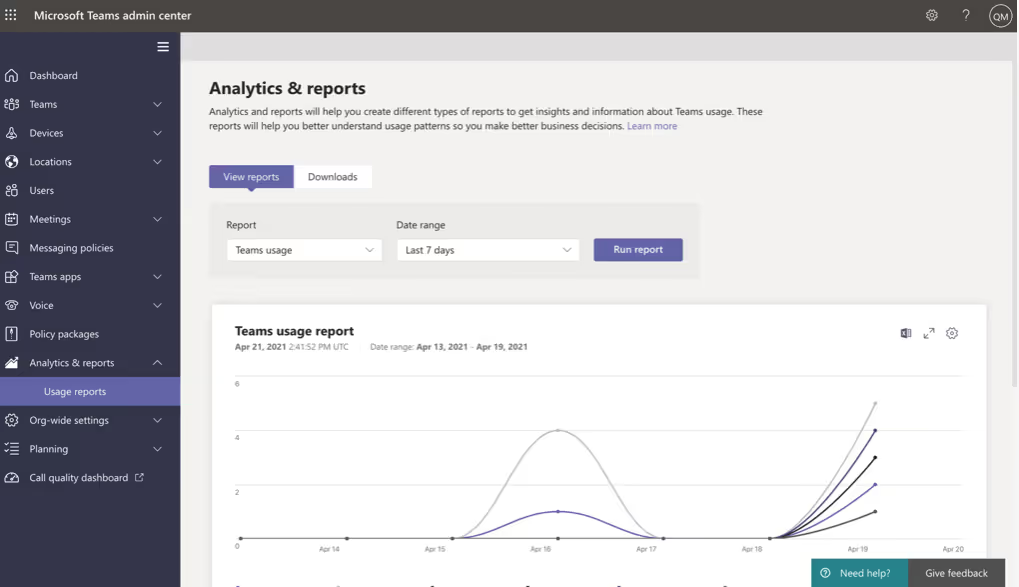
You can filter the info shown on the chart by clicking on one of the items in the legend underneath. In the example below, we can choose from:
- Total active users
- Active channels
- Reply messages
- Post messages
- Channel messages
- Mentions
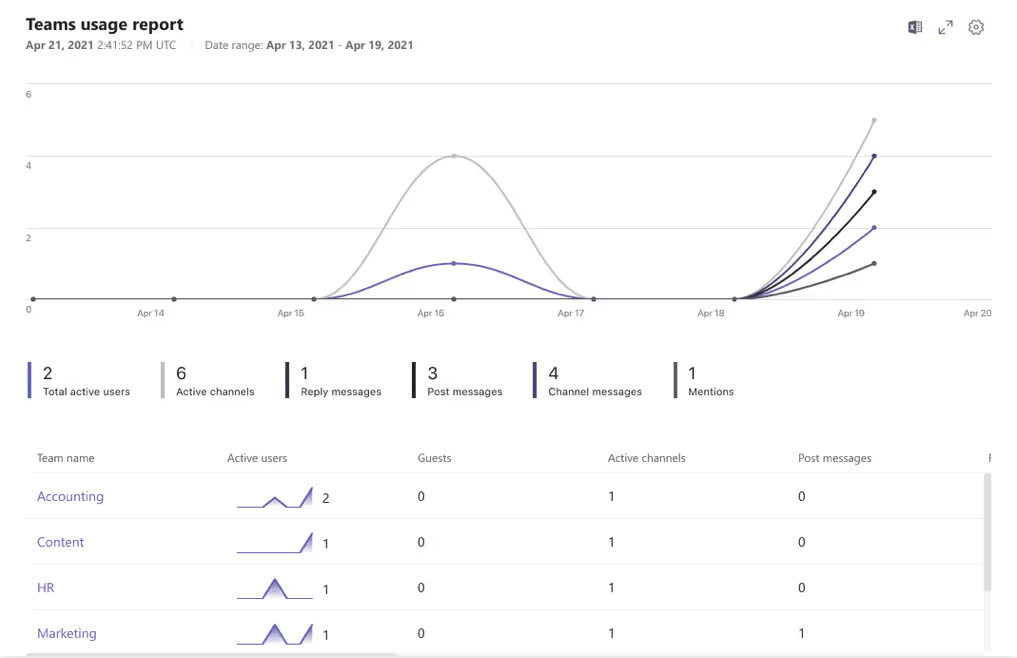
The information in the table underneath the chart gives you a breakdown of usage by each individual team. By scrolling through all the columns to the right, you can see each team’s:
- Name: The display name of the team
- Privacy setting: Whether the team is a private or public team
- Active users: The number of active users in the team
- Guests: The number of guests in the team
- Active channels: The number of channels that have at least one active user
- Post messages: The number of all the post messages in channels
- Reply messages: The number of all the reply messages in channels
- Meetings organized: The number of scheduled and ad hoc meetings a user organized
- Urgent messages: The number of all the urgent messages
- Reactions: The number of all the reactions to messages
- Mentions: The number of all the mentions used in messages
- Channel messages: The number of unique messages that the team’s users posted in a team chat
The Teams usage report is a useful way to gain visibility over what's going on in your teams, but it doesn't necessarily tell the full story. For example, a team could have been created with the goal of completing a specific project. That project may have been put on hold, with plans to revisit it down the line. Therefore, the team would appear inactive but it is not obsolete.
The data contained in the usage report is limited to active users and channels, which means that some of the very teams you are looking for (ones that have been inactive for 90 days or more) won't be listed in the report. You'll need to compare a complete list of your teams with those listed in the report to manually deduce which of them are truly obsolete.
Find inactive teams using a third-party tool
A third-party tool like ShareGate can automate the process of detecting your inactive teams, so that you're taking regular action to clean up your environment.
ShareGate can help you to identify your obsolete teams by regularly crawling through your teams, as well as their associated SharePoint sites and Outlook inboxes looking for user-generated activity.
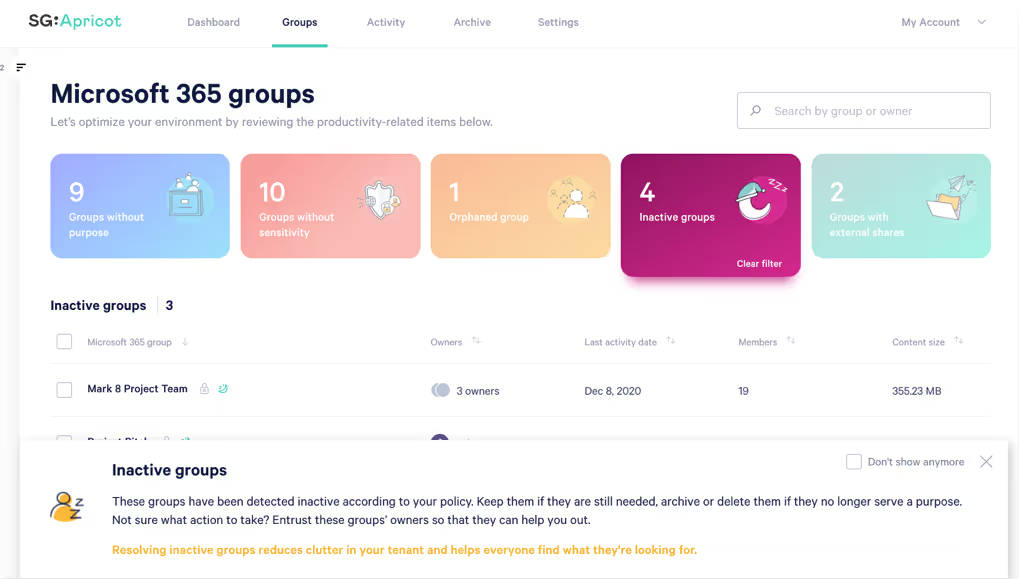
ShareGate's inactivity detection policy lets you decide how long a group or team can exist without any user activity before it is deemed inactive. When a team is flagged as potentially inactive, that team's owner will receive a notification prompting them to archive, delete, or keep the inactive team.
Plus, we recently added a new feature to our favourite Teams management tool, making it easier than ever for you to clean up inactive teams in your tenant. Collaborate with owners via the ShareGate chatbot which allows you to contact owners of inactive teams directly in Microsoft Teams so they can take swift action, keeping your teams organized and up-to-date.
How to archive and delete a Microsoft Teams team
Once you've identified your inactive teams, you need to decide what action you'll take to clean them up. Generally, your options will be to either archive or delete the team. Let's take a look at the differences between each of these actions, as well as the steps to take for each.
How to archive a team in Microsoft Teams
Archiving a team puts an end to all activity associated with that team, including its private channels and SharePoint site. However, it is still possible to add or remove members from the team, and all past activity such as conversations in the chat, or public or private channels, remains accessible.
You can archive teams in the Microsoft Teams admin center by following these steps:
- In the admin center, select Teams, then Manage teams
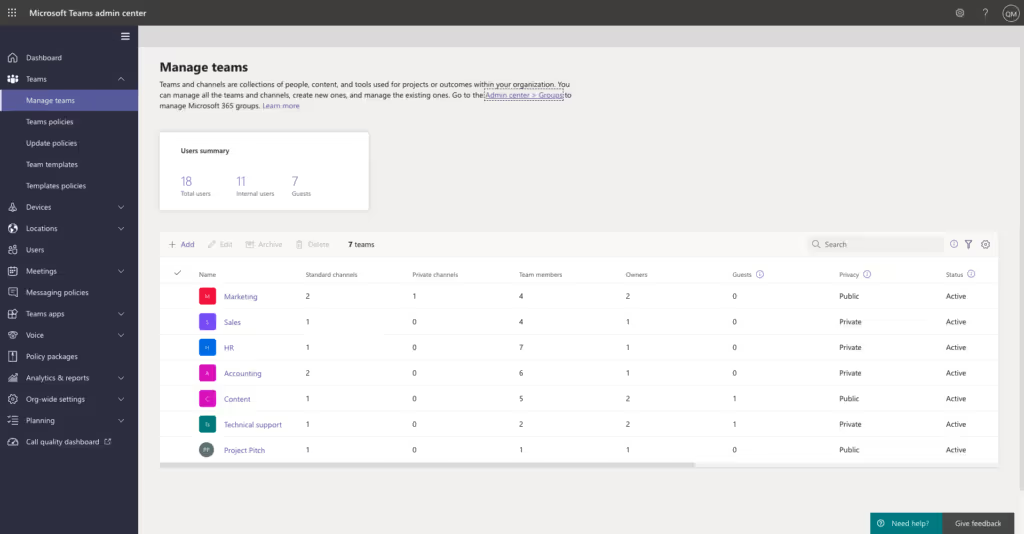
2. Select the team you want to archive, and click Archive
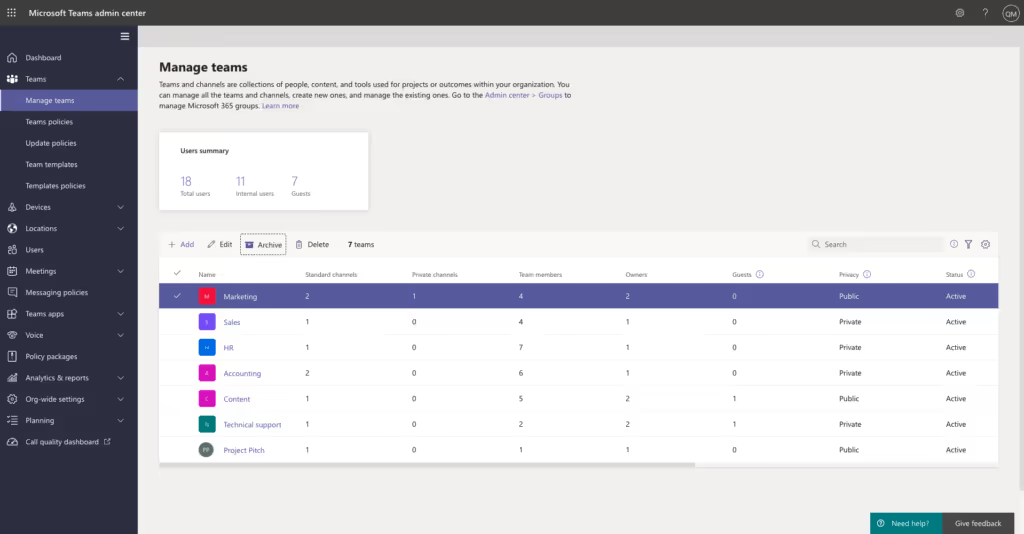
3. You'll see the following pop-up. To prevent people from editing the content in the SharePoint site associated with the team, select Make the SharePoint site read-only for team members. (Teams owners will still be able to edit this content.)
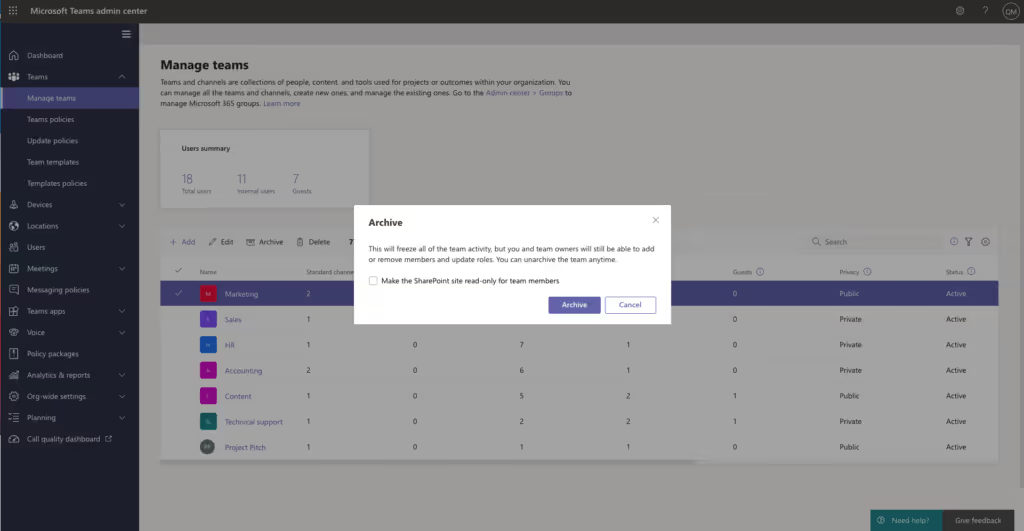
4. Then select Archive. The team’s status will change to Archived.
At any time, the team's owner can follow these same steps to unarchive the team.
How to delete a team in Microsoft Teams
When you're done with a team for good, you can go ahead and delete it.
Here's how:
- In the Microsoft Teams admin center, select Teams, then Manage teams.
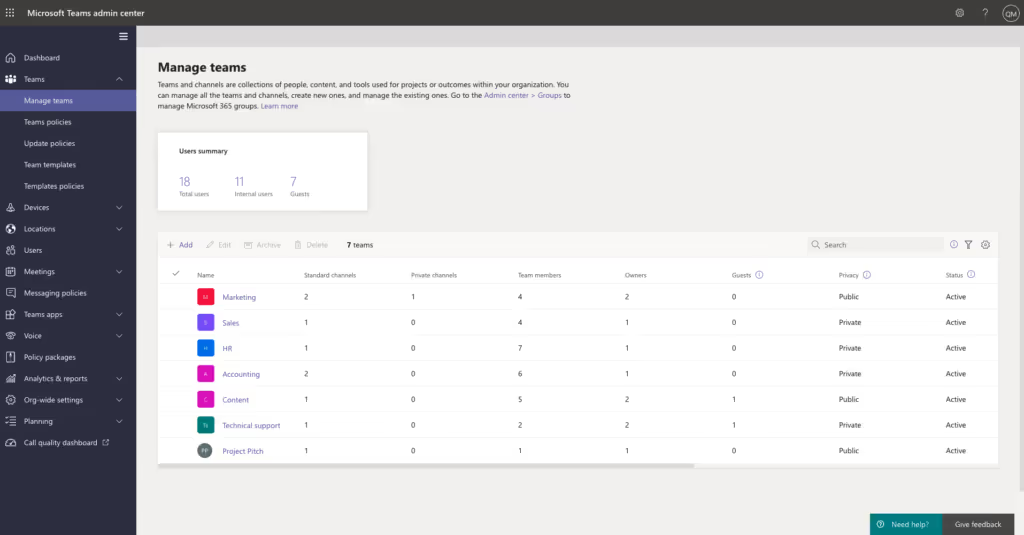
2. Select a team by clicking the team name.
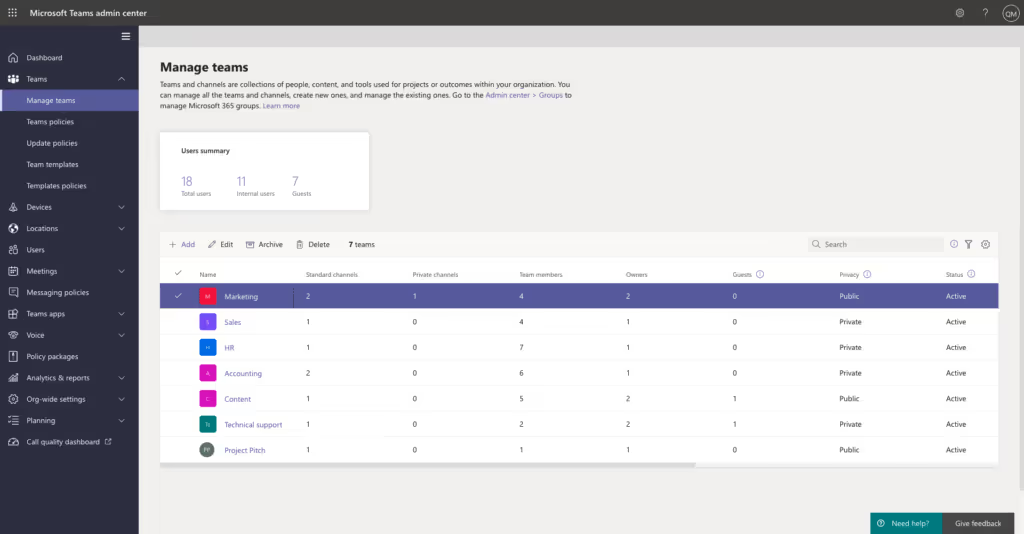
3. Select Delete. A confirmation message will appear.
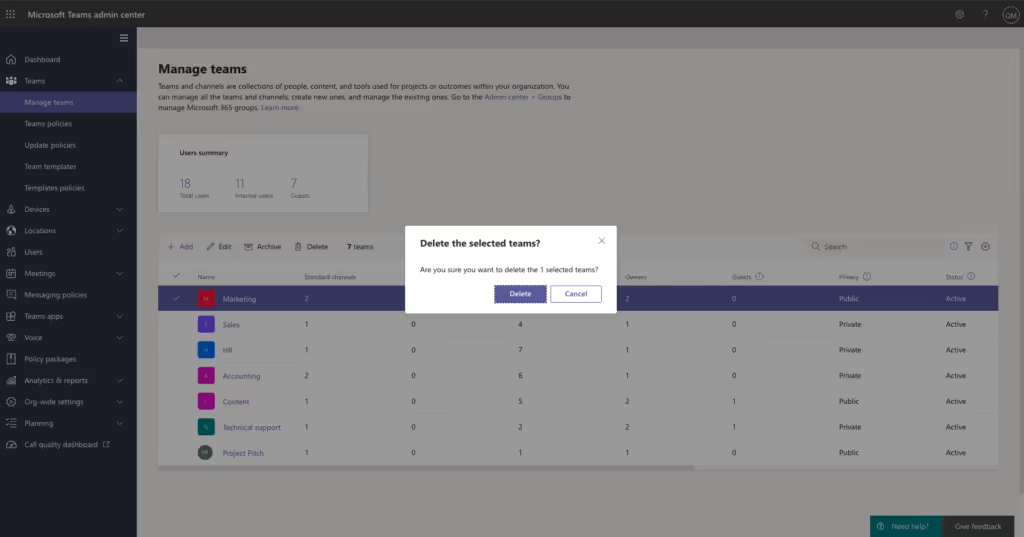
Select Delete to permanently delete the team.
When you delete a team, any activity that has taken place within that team's channels (and associated site collections), files, and chats is also deleted.
Deleted the wrong team? Don't panic! By default, Microsoft 365 groups and their associated teams can be restored within 30 days of deletion. For more information check out our in-depth article on how to archive teams.
That's a wrap! We hope you've enjoyed our series on Microsoft teams Lifecycle management, and feel ready to build your own plan to improve the efficiency and organization of your tenant!
.jpg)


.svg)
.avif)
%20(1).avif)
















